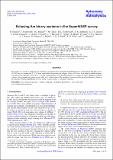Files in this item
Eclipsing Am binary systems in the SuperWASP survey
Item metadata
| dc.contributor.author | Smalley, B. | |
| dc.contributor.author | Southworth, J. | |
| dc.contributor.author | Pintado, O. I. | |
| dc.contributor.author | Gillon, M. | |
| dc.contributor.author | Holdsworth, D. L. | |
| dc.contributor.author | Anderson, D. R. | |
| dc.contributor.author | Barros, S. C. C. | |
| dc.contributor.author | Cameron, A. Collier | |
| dc.contributor.author | Delrez, L. | |
| dc.contributor.author | Faedi, E. | |
| dc.contributor.author | Haswell, C. A. | |
| dc.contributor.author | Hellier, C. | |
| dc.contributor.author | Horne, K. | |
| dc.contributor.author | Jehin, E. | |
| dc.contributor.author | Maxted, P. E. L. | |
| dc.contributor.author | Norton, A. J. | |
| dc.contributor.author | Pollacco, D. | |
| dc.contributor.author | Skillen, I. | |
| dc.contributor.author | Smith, A. M. S. | |
| dc.contributor.author | West, R. G. | |
| dc.contributor.author | Wheatley, P. J. | |
| dc.date.accessioned | 2016-01-25T17:10:04Z | |
| dc.date.available | 2016-01-25T17:10:04Z | |
| dc.date.issued | 2014-04-08 | |
| dc.identifier | 240326760 | |
| dc.identifier | d5095052-59ff-4aeb-9647-7e26f629f430 | |
| dc.identifier | 000334671000069 | |
| dc.identifier | 84898048617 | |
| dc.identifier.citation | Smalley , B , Southworth , J , Pintado , O I , Gillon , M , Holdsworth , D L , Anderson , D R , Barros , S C C , Cameron , A C , Delrez , L , Faedi , E , Haswell , C A , Hellier , C , Horne , K , Jehin , E , Maxted , P E L , Norton , A J , Pollacco , D , Skillen , I , Smith , A M S , West , R G & Wheatley , P J 2014 , ' Eclipsing Am binary systems in the SuperWASP survey ' , Astronomy & Astrophysics , vol. 564 , A69 . https://doi.org/10.1051/0004-6361/201323158 | en |
| dc.identifier.issn | 0004-6361 | |
| dc.identifier.other | ORCID: /0000-0002-8863-7828/work/58531394 | |
| dc.identifier.uri | https://hdl.handle.net/10023/8082 | |
| dc.description.abstract | The results of a search for eclipsing Am star binaries using photometry from the SuperWASP survey are presented. The light curves of 1742 Am stars fainter than V = 8.0 were analysed for the presence of eclipses. A total of 70 stars were found to exhibit eclipses, with 66 having sufficient observations to enable orbital periods to be determined and 28 of which are newly identified eclipsing systems. Also presented are spectroscopic orbits for 5 of the systems. The number of systems and the period distribution is found to be consistent with that identified in previous radial velocity surveys of "classical" Am stars. | |
| dc.format.extent | 20 | |
| dc.format.extent | 4658593 | |
| dc.language.iso | eng | |
| dc.relation.ispartof | Astronomy & Astrophysics | en |
| dc.subject | Stars: chemically peculiar | en |
| dc.subject | Binaries: eclipsing | en |
| dc.subject | Techniques: photometric | en |
| dc.subject | Stars: early-type | en |
| dc.subject | Stars: fundamental parameters | en |
| dc.subject | Low-mass stars | en |
| dc.subject | Light curves | en |
| dc.subject | Spectroscopic binaries | en |
| dc.subject | Absolute dimensions | en |
| dc.subject | Variable-stars | en |
| dc.subject | Main-sequence | en |
| dc.subject | Short-period | en |
| dc.subject | Orbits | en |
| dc.subject | Search | en |
| dc.subject | Catalog | en |
| dc.subject | QB Astronomy | en |
| dc.subject | QC Physics | en |
| dc.subject.lcc | QB | en |
| dc.subject.lcc | QC | en |
| dc.title | Eclipsing Am binary systems in the SuperWASP survey | en |
| dc.type | Journal article | en |
| dc.contributor.sponsor | Science & Technology Facilities Council | en |
| dc.contributor.sponsor | Science & Technology Facilities Council | en |
| dc.contributor.institution | University of St Andrews. School of Physics and Astronomy | en |
| dc.identifier.doi | 10.1051/0004-6361/201323158 | |
| dc.description.status | Peer reviewed | en |
| dc.identifier.grantnumber | ST/J001651/1 | en |
| dc.identifier.grantnumber | PP/F000065/1 | en |
This item appears in the following Collection(s)
Items in the St Andrews Research Repository are protected by copyright, with all rights reserved, unless otherwise indicated.

